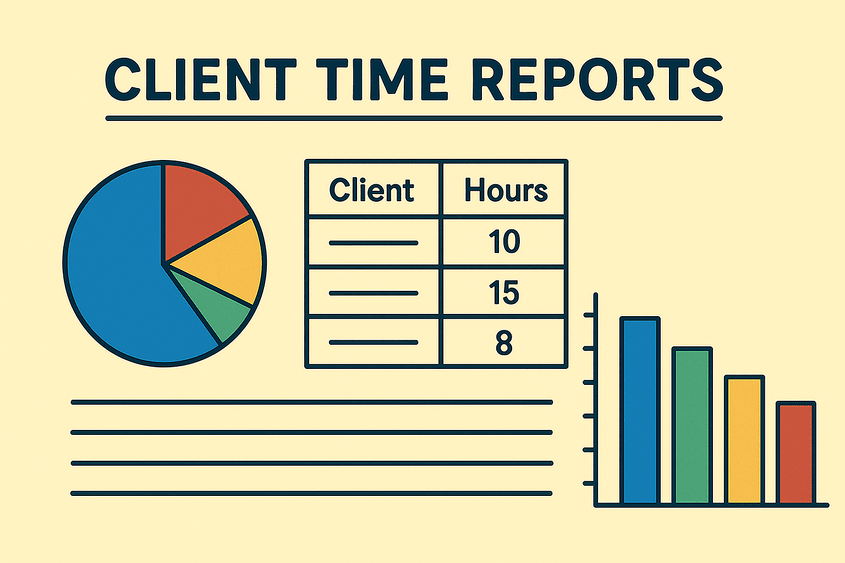Client Time Reports: Definition, Benefits and How to Create Them
Gain insights into time reports: what they are, why they are used, and how to generate them for accurate billing and payroll.

What Are Client Time Reports?
A client time report provides summarized information from time-tracking data. These reports help businesses ensure accurate client billing, track project progress, and analyze productivity.
Key Components of Client Time Reports
A client time report presents information in an organized and structured way. Its key components include:
Hours Tracked per Client
This column/metric shows the total time spent working for each client. It ensures accurate billing and measures resource consumption.
Billable vs. Non-Billable Hours
This column/metric displays the billable and non-billable time spent on tasks. It is directly tied to revenue and invoicing.
Task and Activity Breakdown
A line-by-line list of what the time was spent on, either a task or an activity. This gives clarity into how time is allocated within projects.
Team Member Contributions
This metric shows which employees worked on tasks or projects and how much time each contributed. This brings transparency and fair workload distribution.
Time Period Selection
This option allows you set a time period to view and analyze report data within specific dates or a chosen range. It's usually represented as a date picker/calendar.
Benefits of Client Time Reports
Client time reports help service businesses, agencies, and freelancers link work done to value delivered. Their key benefits are:
Transparency and Trust with Clients
By showing clients exactly what work was done and how much time it took, client time reports help strengthen trust.
Accurate Invoicing and Fewer Disputes
Accurate time reports eliminate invoicing errors, ensuring clients pay only for the work actually delivered.
Better Project Management
Managers can use time reports to see where employee hours go, allowing them to track project progress and allocate resources more effectively.
Productivity and Resource Insights
Time reports show employee efficiency and resource use, helping businesses remove bottlenecks and boost performance.
Legal Compliance and Audit Trail
Client time reports offer a formal audit trail to ensure compliance and guard against billing disputes.
How to Create Client Time Reports
Here is step-by-step guidance for generating accurate and organized reports that track time spent on client work.
Step 1 – Collect Accurate Time Data
Track time spent on client tasks in real time with the tool or software that fits your company’s needs.
Step 2 – Choose the Right Tool or Software
Choose a platform that provides real-time tracking, client/project time assignment, and customizable reporting.
Step 3 – Customize Report Fields
Ensure the report’s fields and details comply with invoicing rules and meet the client’s requirements.
Step 4 – Generate and Format the Report
Create the report for the billing period you need and export a clean, branded PDF or spreadsheet.
How to Use Client Time Reports Effectively
When the reports are ready, there are many ways to use them. They bring billing transparency, productivity insights, and data for invoicing and payroll.
For Billing and Invoicing
Client time reports help you streamline billing by precisely capturing hours and rates, resulting in transparent invoices that clients are less likely to dispute.
For Client Communication
By offering a transparent view of tasks and progress, client time reports effectively build client trust and provide the necessary detail to support your invoices.
For Internal Performance Tracking
By analyzing client time reports, you can effectively measure productivity, identify and correct workflow bottlenecks, and ultimately improve team performance.
Integration with Accounting and BI Tools
Integrating client time reports with accounting and BI tools enables automated invoicing, accurate payroll, and deeper financial insights.
Client Time Reports with TMetric
TMetric's core strength lies not only in its ability to accurately capture time, but also in its strong reporting features. TMetric allows you to review and analyze client time tracking data using the Projects Summary report or the Detailed report. You can group data by client and export a customized report for further use.
Conclusion
Client time reports are key to business efficiency and trust. They guarantee accurate billing, reveal productivity insights, and ensure clear communication. Tools like TMetric allow businesses to effortlessly track time, manage resources, and maintain the transparency with powerfull reports.
